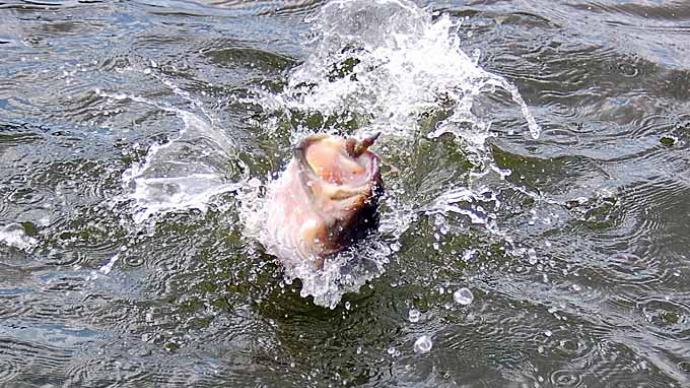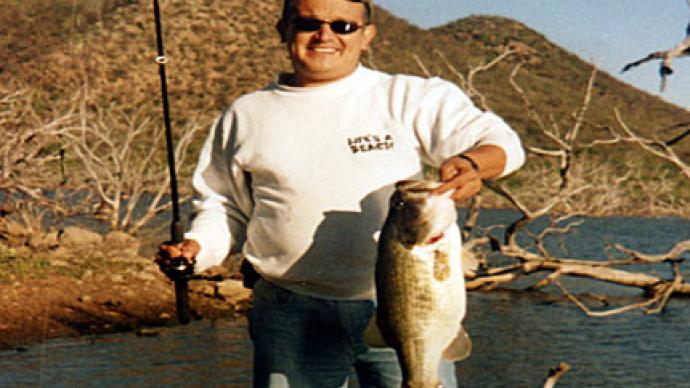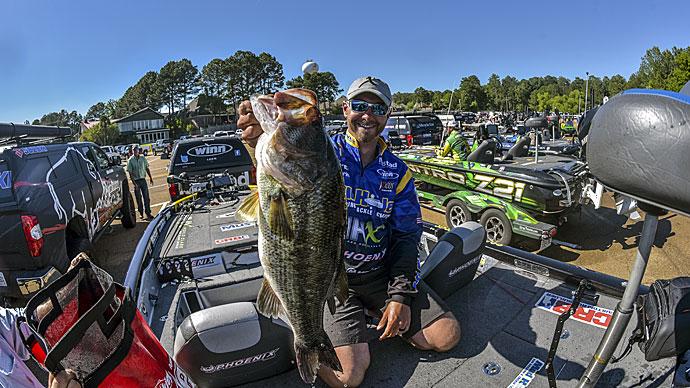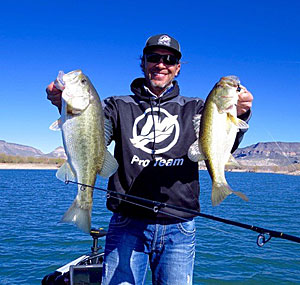
A Texas rig is a hook with a bullet sinker in front of it, but even that is contested. Is it still a Texas rig if you don’t embed the hook point back into the worm? Some people add a bead between the sinker and the hook. Is it a Texas rig if you don’t use a weight, or do you add a bead? No matter: starting with a hook and a bullet sinker, you can put together an almost limitless variety of fishing rigs, and you are free to call them whatever you want. You can Texas rig weedless or with an open hook, you can peg or not peg the sinker. Then there are the endless varieties and weights of sinkers, including floating sinkers. There are also many different sizes and shapes of hooks, making the Texas rig one of the most versatile ways to fish for bass.
Arizona pro Kevin Finley (sponsored by Trapp Technology and Mercury Outboards) uses a Texas rig to target pre-spawn bass in one of Arizona’s most challenging bass lakes – Lake Pleasant. In mid-January, Finley fishes a 6.5-inch Strike King KVD worm with an eighth-ounce sinker. It can be challenging to feel the worm with a light weight, so Finley uses a braid with a Sunline Shooter Fluorocarbon 14-pound-test leader joined with an Alberto Knot.
Feeling what the worm is doing is key to fishing a Texas rig. Fish often softly suck the bait in and spit it back out, and if you can’t feel that subtle movement, you’ll miss a ton of bites. Kevin spent over a grand on line and tested tons of fluorocarbons to find one he could have confidence in. “The biggest problem with fluorocarbon is knot strength, and Sunline Shooter has the best knot strength of any I’ve tried,” he said. He also throws braid more than most guys, he says – he even uses it on deep diving cranks because he can feel everything with it.
Finley only pegs the sinker when he has to, usually in heavy cover like vegetation or brush. He feels like he catches fewer fish when he pegs the sinker because when a fish sucks the bait in, the sinker doesn’t go with it. This makes it easier to set the hook. He often fishes with a floating worm, so giving the line a little slack makes the worm swim up a bit from the sinker and wave around just off the bottom.
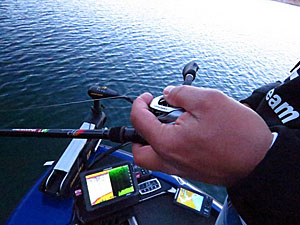
When the bait crawls through the thick stuff, an unpegged sinker can fall on the opposite side of a stick-up from the bait, getting you hung up a lot more often. There are tons of ways to peg sinkers. Some sinkers already have a pegging device, like a small spring or a throat and barb. It can be difficult to run these into the worm because the hook is already very near the top, and once that spring or barb has torn loose, the top of the worm is pretty much destroyed. This means you either keep shortening your bait or get a new one. One of the best ways to peg a hook is with a rubber nail. This keeps the line intact, doesn’t mess with the bait itself, and can even be moved on the line so that you can slide it up if you need to re-tie. Some guys use a toothpick, but jamming wood into the weight can put a crimp in your line that can cause it to fail. The rubber nail holds tight without damaging the line. Just insert the rubber nail starting at the wide end and pull until it’s snug. Clip off the excess.
Finley uses color on his baits more often than he uses scent. The Strike King KVD worms he’s using are impregnated with plenty of salt and a coffee scent that masks human scent. But he often dips his worms in chartreuse or red dye – he says it seems to help a lot. During the U.S. Open tournament, he dipped his worm in red, and on the next cast, he caught a fish and put 12 pounds in the boat during the following half hour.
Flipping is a fantastic way to fish a Texas rig, and there isn’t room to do the technique justice in this story. When he’s flipping, Kevin always pegs the sinker, saying that people's biggest mistake is to flip the outside edges of stuff. He always flips right into the middle of a tree or a brush pile. He almost always uses braid to flip and admits that it can be frustrating because the wet braid digs into the reel and gets hung up all the time. But all that is worth it once a big bass hits that lure, and the braid lets you haul it out no matter how thick the cover is. The only exception to his using braid is if he’s flipping into wood – the braid hangs up too much in that situation.
When we were at Pleasant in mid-January, Finley took us to a spot in the back of one of the main feeder creeks to the lake. He tied on a Reaction Innovations Skinny Dipper lure (Texas-rigged), threw it out, then let it sit for a few seconds without moving it. After the short wait, he cranked steadily to make the lure swim just off the bottom. Well, that place must be called Toadville because he and his non-boater put a steady stream of hawgs in the boat within just a few minutes. That’s the beauty of a Texas rig – you can fish it shallow or deep.
Tips
Kevin has two massive Lowrance graphs on his Nitro console, which lets him examine structure as he idles over it. The big graphs show a lot of detail, mainly because he runs both of them with different things on the split screen. He can tell whether something is structure, cover, or fish by comparing the two images. He looks for subtle things like steep drops, even small ones, fingers that run out from shallow to deep, or a rockpile on a point or a flat. He took us to two places you would have sworn were shallow flats because of the land's lay, but both had good drop-offs and held fish. Such was the case with Kevin’s honey hole – it looked like a flat but had a nice steep break off one side.
You don’t have to stick to deep-water structure to be successful with a Texas rig. The beauty of this technique is its versatility. You can Texas rig a grub with a floating sinker (pegged) and swim it across the surface no matter how many stick-ups there are. That curly tail slaps on the water like a dinner bell for bass. You can fish a Texas-rigged worm through weeds on the shoreline or in 45 feet of water. You can drop it down a bluff or swim it over a flat. For structure fishing, though, a Texas rig is hard to beat.
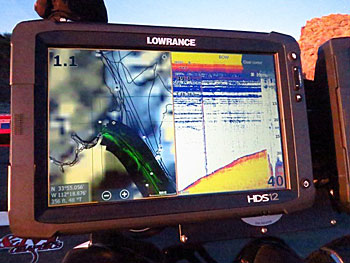
California pro Mike Folkstad says that a major mistake that fishermen everywhere make is when they are dragging their lure over a rock or a tree. If you keep the line taut at this point, the lure will pendulum away from the structure as it falls. It may land more than a yard away. Mike says that the instant you feel your lure begin to fall, you need to give it slack. This may mean leaning forward and sticking your rod out. Whatever. Give it enough slack to fall straight down.
A good worm rod should have a sensitive tip so you can feel bites but plenty of backbone for stout hooksets. A nice long handle will let you hold the rod against your side and keep a couple of fingers on the line.
If you’re fishing what looks like a dynamite spot, but you’re not getting bit, try fishing uphill or across the structure. If the fish are holding on cover to one side, they might not see your worm until it comes by at a different angle.
Kevin says that fluorocarbon line does stretch, but only once. To take that initial stretch out of his Shooter line, he ties one end to a fence post or something at home, then walks far away and stretches the line out. This means it won’t stretch while he’s trying to set the hook on a big fish at the lake.
Match hook size to the bait. A big fat grub will need a wider hook than a 4-inch finesse worm. You need enough space between the lure body and the hook shaft to leave room for the lure to move aside when you slam the point home.
The weight of the sinker can be crucial. The more active the fish are, the heavier the sinker can be and the faster you can move it. If you’re not getting bit, try fishing smaller and slower. You don’t have to use a smaller bait, just a smaller weight. Once you get down to small bullet sinkers, you may find it easier to throw them on spinning gear. Just keep a finger on that line so you can feel the subtle bites.
Sometimes you don’t get a “bite.” You may suddenly feel nothing like someone cut your line. You may feel like you hooked a rubber band, or it might feel like something just twitched the line a couple of times. When you’re swimming a bait like we were at Pleasant, it’s not subtle at all – they just slam it and run off with it, but some Texas rigs bites are subtle, and you just need time and experience to learn what they feel like.
BassResource may receive a portion of revenues if you make a purchase using a link above.


